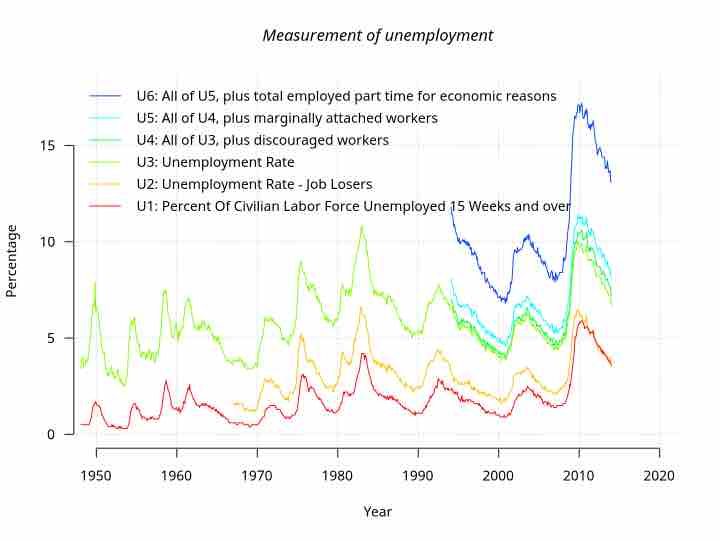Unemployment, for the purposes of this atom, occurs when people are without work and actively seeking work. The unemployment rate is a measure of the prevalence of unemployment. It is calculated as a percentage by dividing the number of unemployed individuals by all individuals currently in the labor force.
Though many people care about the number of unemployed individuals, economists typically focus on the unemployment rate. This corrects for the normal increase in the number of people employed due to increases in population and increases in the labor force relative to the population.
As defined by the International Labour Organization (ILO), "unemployed workers" are those who are currently not working but willing and able to work for pay, those who are currently available to work, and those who have actively searched for work. Individuals who are actively seeking job placement must make the following efforts:
- be in contact with an employer
- have job interviews
- contact job placement agencies
- send out resumes
- submit applications
- respond to advertisements (or some other means of active job searching) within the prior four weeks
There are different ways national statistical agencies measure unemployment. These differences may limit the validity of international comparisons of unemployment data. To some degree, these differences remain despite national statistical agencies increasingly adopting the definition of unemployment by the International Labor Organization. To facilitate international comparisons, some organizations, such as the OECD, Eurostat, and International Labor Comparisons Program, adjust data on unemployment for comparability across countries.
The ILO describes 4 different methods to calculate the unemployment rate:
- Labor Force Sample Surveys are the most preferred method of unemployment rate calculation since they give the most comprehensive results and enable calculation of unemployment by different group categories such as race and gender. This method is the most internationally comparable.
- Official Estimates are determined by a combination of information from one or more of the other three methods. The use of this method has been declining in favor of labor surveys.
- Social Insurance Statistics, such as unemployment benefits, are computed base on the number of persons insured representing the total labor force and the number of persons who are insured that are collecting benefits. This method has been heavily criticized due to the expiration of benefits before the person finds work.
- Employment Office Statistics are the least effective, being that they only include a monthly tally of unemployed persons who enter employment offices. This method also includes unemployed who are not unemployed per the ILO definition.
Unemployment in the United States
The Bureau of Labor Statistics measures employment and unemployment (of those over 15 years of age) using two different labor force surveys conducted by the United States Census Bureau (within the United States Department of Commerce) and/or the Bureau of Labor Statistics (within the United States Department of Labor). These surveys gather employment statistics monthly. The Current Population Survey (CPS), or "Household Survey," conducts a survey based on a sample of 60,000 households. This survey measures the unemployment rate based on the ILO definition.
The Current Employment Statistics survey (CES), or "Payroll Survey", conducts a survey based on a sample of 160,000 businesses and government agencies that represent 400,000 individual employers. This survey measures only civilian nonagricultural employment; thus, it does not calculate an unemployment rate, and it differs from the ILO unemployment rate definition.
These two sources have different classification criteria and usually produce differing results. Additional data are also available from the government, such as the unemployment insurance weekly claims report available from the Office of Workforce Security, within the U.S. Department of Labor Employment & Training Administration.
The Bureau of Labor Statistics also calculates six alternate measures of unemployment, U1 through U6 (as diagramed in ), that measure different aspects of unemployment:

U.S. Unemployment Measures
U1–U6 from 1950–2010, as reported by the Bureau of Labor Statistics.
- U1: Percentage of labor force unemployed 15 weeks or longer.
- U2: Percentage of labor force who lost jobs or completed temporary work.
- U3: Official unemployment rate per the ILO definition occurs when people are without jobs and they have actively looked for work within the past four weeks.
- U4: U3 + "discouraged workers", or those who have stopped looking for work because current economic conditions make them believe that no work is available for them.
- U5: U4 + other "marginally attached workers," "loosely attached workers," or those who "would like" and are able to work, but have not looked for work recently.
- U6: U5 + Part-time workers who want to work full-time, but cannot due to economic reasons (underemployment).